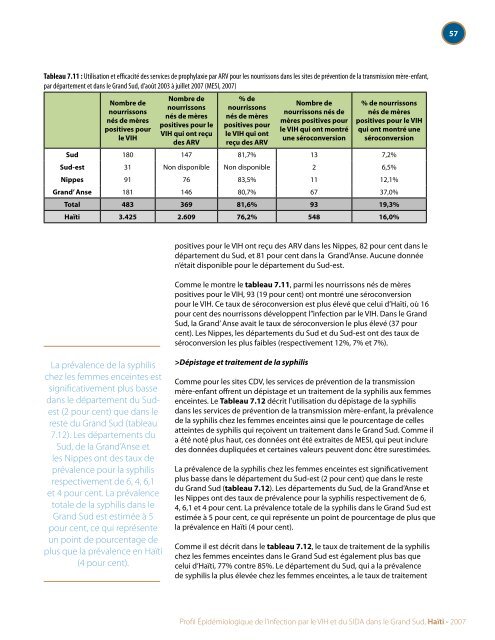Profil Épidémiologique de l'infection par le VIH et du SIDA ... - nastad
Profil Épidémiologique de l'infection par le VIH et du SIDA ... - nastad
Profil Épidémiologique de l'infection par le VIH et du SIDA ... - nastad
Create successful ePaper yourself
Turn your PDF publications into a flip-book with our unique Google optimized e-Paper software.
Tab<strong>le</strong>au 7.11 : Utilisation <strong>et</strong> efficacité <strong>de</strong>s services <strong>de</strong> prophylaxie <strong>par</strong> ARV pour <strong>le</strong>s nourrissons dans <strong>le</strong>s sites <strong>de</strong> prévention <strong>de</strong> la transmission mère-enfant,<br />
<strong>par</strong> dé<strong>par</strong>tement <strong>et</strong> dans <strong>le</strong> Grand Sud, d’août 2003 à juil<strong>le</strong>t 2007 (MESI, 2007)<br />
Nombre <strong>de</strong><br />
nourrissons<br />
nés <strong>de</strong> mères<br />
positives pour<br />
<strong>le</strong> <strong>VIH</strong><br />
Nombre <strong>de</strong><br />
nourrissons<br />
nés <strong>de</strong> mères<br />
positives pour <strong>le</strong><br />
<strong>VIH</strong> qui ont reçu<br />
<strong>de</strong>s ARV<br />
% <strong>de</strong><br />
nourrissons<br />
nés <strong>de</strong> mères<br />
positives pour<br />
<strong>le</strong> <strong>VIH</strong> qui ont<br />
reçu <strong>de</strong>s ARV<br />
positives pour <strong>le</strong> <strong>VIH</strong> ont reçu <strong>de</strong>s ARV dans <strong>le</strong>s Nippes, 82 pour cent dans <strong>le</strong><br />
dé<strong>par</strong>tement <strong>du</strong> Sud, <strong>et</strong> 81 pour cent dans la Grand’Anse. Aucune donnée<br />
n’était disponib<strong>le</strong> pour <strong>le</strong> dé<strong>par</strong>tement <strong>du</strong> Sud-est.<br />
Comme <strong>le</strong> montre <strong>le</strong> tab<strong>le</strong>au 7.11, <strong>par</strong>mi <strong>le</strong>s nourrissons nés <strong>de</strong> mères<br />
positives pour <strong>le</strong> <strong>VIH</strong>, 93 (19 pour cent) ont montré une séroconversion<br />
pour <strong>le</strong> <strong>VIH</strong>. Ce taux <strong>de</strong> séroconversion est plus é<strong>le</strong>vé que celui d’Haïti, où 16<br />
pour cent <strong>de</strong>s nourrissons développent l’’infection <strong>par</strong> <strong>le</strong> <strong>VIH</strong>. Dans <strong>le</strong> Grand<br />
Sud, la Grand’ Anse avait <strong>le</strong> taux <strong>de</strong> séroconversion <strong>le</strong> plus é<strong>le</strong>vé (37 pour<br />
cent). Les Nippes, <strong>le</strong>s dé<strong>par</strong>tements <strong>du</strong> Sud <strong>et</strong> <strong>du</strong> Sud-est ont <strong>de</strong>s taux <strong>de</strong><br />
séroconversion <strong>le</strong>s plus faib<strong>le</strong>s (respectivement 12%, 7% <strong>et</strong> 7%).<br />
>Dépistage <strong>et</strong> traitement <strong>de</strong> la syphilis<br />
Nombre <strong>de</strong><br />
nourrissons nés <strong>de</strong><br />
mères positives pour<br />
<strong>le</strong> <strong>VIH</strong> qui ont montré<br />
une séroconversion<br />
% <strong>de</strong> nourrissons<br />
nés <strong>de</strong> mères<br />
positives pour <strong>le</strong> <strong>VIH</strong><br />
qui ont montré une<br />
séroconversion<br />
Sud 180 147 81,7% 13 7,2%<br />
Sud-est 31 Non disponib<strong>le</strong> Non disponib<strong>le</strong> 2 6,5%<br />
Nippes 91 76 83,5% 11 12,1%<br />
Grand’ Anse 181 146 80,7% 67 37,0%<br />
Total 483 369 81,6% 93 19,3%<br />
Haïti 3.425 2.609 76,2% 548 16,0%<br />
La préva<strong>le</strong>nce <strong>de</strong> la syphilis<br />
chez <strong>le</strong>s femmes enceintes est<br />
significativement plus basse<br />
dans <strong>le</strong> dé<strong>par</strong>tement <strong>du</strong> Su<strong>de</strong>st<br />
(2 pour cent) que dans <strong>le</strong><br />
reste <strong>du</strong> Grand Sud (tab<strong>le</strong>au<br />
7.12). Les dé<strong>par</strong>tements <strong>du</strong><br />
Sud, <strong>de</strong> la Grand’Anse <strong>et</strong><br />
<strong>le</strong>s Nippes ont <strong>de</strong>s taux <strong>de</strong><br />
préva<strong>le</strong>nce pour la syphilis<br />
respectivement <strong>de</strong> 6, 4, 6,1<br />
<strong>et</strong> 4 pour cent. La préva<strong>le</strong>nce<br />
tota<strong>le</strong> <strong>de</strong> la syphilis dans <strong>le</strong><br />
Grand Sud est estimée à 5<br />
pour cent, ce qui représente<br />
un point <strong>de</strong> pourcentage <strong>de</strong><br />
plus que la préva<strong>le</strong>nce en Haïti<br />
(4 pour cent).<br />
Comme pour <strong>le</strong>s sites CDV, <strong>le</strong>s services <strong>de</strong> prévention <strong>de</strong> la transmission<br />
mère-enfant offrent un dépistage <strong>et</strong> un traitement <strong>de</strong> la syphilis aux femmes<br />
enceintes. Le Tab<strong>le</strong>au 7.12 décrit l’utilisation <strong>du</strong> dépistage <strong>de</strong> la syphilis<br />
dans <strong>le</strong>s services <strong>de</strong> prévention <strong>de</strong> la transmission mère-enfant, la préva<strong>le</strong>nce<br />
<strong>de</strong> la syphilis chez <strong>le</strong>s femmes enceintes ainsi que <strong>le</strong> pourcentage <strong>de</strong> cel<strong>le</strong>s<br />
atteintes <strong>de</strong> syphilis qui reçoivent un traitement dans <strong>le</strong> Grand Sud. Comme il<br />
a été noté plus haut, ces données ont été extraites <strong>de</strong> MESI, qui peut inclure<br />
<strong>de</strong>s données <strong>du</strong>pliquées <strong>et</strong> certaines va<strong>le</strong>urs peuvent donc être surestimées.<br />
La préva<strong>le</strong>nce <strong>de</strong> la syphilis chez <strong>le</strong>s femmes enceintes est significativement<br />
plus basse dans <strong>le</strong> dé<strong>par</strong>tement <strong>du</strong> Sud-est (2 pour cent) que dans <strong>le</strong> reste<br />
<strong>du</strong> Grand Sud (tab<strong>le</strong>au 7.12). Les dé<strong>par</strong>tements <strong>du</strong> Sud, <strong>de</strong> la Grand’Anse <strong>et</strong><br />
<strong>le</strong>s Nippes ont <strong>de</strong>s taux <strong>de</strong> préva<strong>le</strong>nce pour la syphilis respectivement <strong>de</strong> 6,<br />
4, 6,1 <strong>et</strong> 4 pour cent. La préva<strong>le</strong>nce tota<strong>le</strong> <strong>de</strong> la syphilis dans <strong>le</strong> Grand Sud est<br />
estimée à 5 pour cent, ce qui représente un point <strong>de</strong> pourcentage <strong>de</strong> plus que<br />
la préva<strong>le</strong>nce en Haïti (4 pour cent).<br />
Comme il est décrit dans <strong>le</strong> tab<strong>le</strong>au 7.12, <strong>le</strong> taux <strong>de</strong> traitement <strong>de</strong> la syphilis<br />
chez <strong>le</strong>s femmes enceintes dans <strong>le</strong> Grand Sud est éga<strong>le</strong>ment plus bas que<br />
celui d’Haïti, 77% contre 85%. Le dé<strong>par</strong>tement <strong>du</strong> Sud, qui a la préva<strong>le</strong>nce<br />
<strong>de</strong> syphilis la plus é<strong>le</strong>vée chez <strong>le</strong>s femmes enceintes, a <strong>le</strong> taux <strong>de</strong> traitement<br />
<strong>Profil</strong> <strong>Épidémiologique</strong> <strong>de</strong> l’infection <strong>par</strong> <strong>le</strong> <strong>VIH</strong> <strong>et</strong> <strong>du</strong> <strong>SIDA</strong> dans <strong>le</strong> Grand Sud, Haïti - 2007<br />
57


